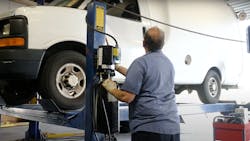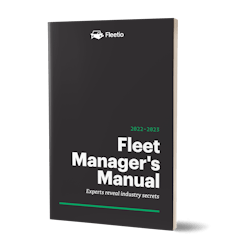Four shop management tips to improve fleet uptime
Regardless of the industry, if an organization relies on fleet assets to deliver goods or services or provide transportation, maximizing uptime is critical.
Downtime impacts an organization’s profitability in multiple ways, including revenue loss, increased service spend, and reduced productivity relative to an asset’s total cost of ownership. Because downtime stems from a multitude of sources, fleet leaders must take a multi-pronged approach to resolving it.
And to help management do this, along with tracking data better and optimizing processes, Fleetio, a fleet management software provider, created the Fleet Manager’s Manual.
The company talked with several professionals across the fleet industry to gain insights into improving performance, and while you will certainly find benefits from reading every page, we know your time is valuable and have curated the top four tips for successfully improving fleet uptime.
1. Improve preventive maintenance adherence
Preventive maintenance (PM) is a fleet’s first line of defense against downtime. Herman VanDenBogaert, fleet and raw material purchasing manager at Cherrylake, a Florida-based tree farm, used fleet management software (FMS) and other fleet solutions to surface causes of the fleet’s inflated service spend. He found that the fleet was underperforming with PM adherence, which was causing repair costs of over $500,000.
“Our PM schedule wasn’t really on a routine. We’d have cases where an operator would just show up and say, ‘Hey, this is broken.’ Of course, that’s a problem because it messes with our schedule for the day and causes downtime,” explains Herman.
To improve PM adherence, Herman started sending PM reminders via FMS and calendar invites for operators to bring their equipment in, as well as using digital inspection forms that alerted him of failed inspection items in real time.
Download the 2022-2023 Fleetio Fleet Manager's Manual HERE.
2. Make clear communication a priority
A big contributor to downtime is ineffective communication. There are a lot of moving parts in fleet and, especially when cross-departmental collaboration is needed, clear communication can go a long way in improving uptime. For Cherrylake, this meant ensuring any employee who contributed to the service workflow process understood how to get the ball rolling. “Having [our] purchasers in [FMS] has been a big part of [breakdown response and issue resolution] improvement,” he says. “If we know we’re going to need parts, I add a purchaser as a person responsible [in our FMS] to ensure they’re getting that communication and can communicate back.”
“Having the operators know what they need to do to get orders going in addition to the purchasers being in the mix really streamlines everything. Once the operator puts in the order request, the purchasers place the order and relay the part’s arrival time to both the operator and mechanics. What this means for the mechanics is: If it’s going to take a week to get the parts, they can set this repair to the side — schedule that work for when the part comes in — and move on to the next job,” Herman explains. “All that stuff that used to be sitting in and around the shop has been minimized because of that communication flow and making sure the mechanics know what jobs have a wait time so they can prioritize others. It sounds like the simplest thing, but communication is such a large part of running a smooth operation.”
3. Reduce unnecessary delays in the shop
Clear communication is also an important part of reducing downtime caused by delays in the shop — something Umair Tahir, director of fleet at DeliverOL, a Georgia logistics company, realized soon after joining the company. Umair switched the fleet's maintenance from multiple third-party shops to Pep Boys National for easier management; however, that didn't completely solve the issue of shop delays.
“Shops always just called or emailed me stuff over. I looked at it; if I didn’t like something — didn’t like the price, something didn’t need to be done — or they had recommendations, I had to email them back. They had to change it, then email me back again until we figured it out,” Umair explains. “We started losing things here and there — papers got misplaced for work that was done. We couldn’t keep up with warranty parts. It was a mess for one person to try to handle shops across the entire country.”
Since implementing outsourced maintenance automation (OMA) to allow for streamlined communication and automated data capture, Umair says: “I’ve definitely gotten a lot more ‘in it’ with the shops, understanding their process — how fast they can do things. We still talk on almost a daily basis about what’s coming in and timelines. The guys at the shops are usually like, ‘We got you; we know how you are,’ because they start knowing you and you start knowing them regarding the way you like to do things, how they like to do things, prices you’ve set and the like.” This process has made managing service much easier, and improved how quickly assets get into the shop and back out on the road. “We don’t have cases where a vehicle that’s ready winds up sitting in the shop for days because no one knows.”[9]
4. Automate workflows when possible
A major theme Fleetio found when it came to improving uptime is automation. Automating fleet processes can help with improving PM compliance and communication, as well as streamline service workflows to minimize the time assets spend in the shop. For Cherrylake, implementing process automation with FMS has decreased downtime caused by major repairs. “Part of that is due to inspections,” says Herman. “Inspection-related issues, now, are added in [FMS] by the operators, [and] inspections automatically initiate issues on failed items and communicate those straight to my mechanics — they repair it the next day.” This process has become routine across the fleet, decreasing its previous $500,000 repair spend to about $350,000.
For DeliverOL, automating the service workflow has eliminated instances of shops performing unapproved work. “We started getting into arguments about what’s okay to do and what’s not, because we were paying for unapproved work and so were the shops, which really was frustrating,” he explains. “[OMA] streamlined everything; the work order goes to OMA, and you can see everything right in front of you. You can communicate back and forth with the shop right on one screen. OMA put everything in one spot for us — everything — so we can see what our total cost is, and what each van is costing us. It’s helped us a lot with headaches and downtime.”
Rachael Plant is a content marketing specialist for Fleetio, a fleet management software company that helps organizations track, analyze and improve their fleet operations.


